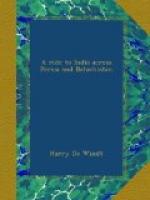The road from Mourghab to Kawamabad is wild and picturesque, leading through a narrow gorge, on either side of which are precipitous cliffs of rock and forest, three or four hundred feet high. A broad, swift torrent dashes through the valley, which is about a quarter of a mile broad. In places the pathway, hewn out of the solid rock, is barely three feet wide, without guard or handrail of any kind. This part of the journey was reached at sunset, and we did not emerge on the plain beyond till after dark. Our horses were, fortunately, as active as cats, and knew their way well, for to guide them was impossible. In places one’s foot actually swung over the precipice, and a false step must have sent one crashing over the side and into the roaring torrent below, which, perhaps luckily, we could only hear, not see.
The ruins of Persepolis are situated about fifty miles north-east of Shiraz, two or three miles from the main road. Signs that we were approaching the famous city were visible for some distance before we actually reached them. Not fifty yards from the post-house of Poozeh, a picturesque spot surrounded by a chain of rocky, snow-capped hills, we came upon a kind of cave, with carvings in bas-relief on its granite walls, representing figures of men and horses from eight to ten feet high, evidently of great antiquity. The desecrating hand of the British tourist had, however, left its mark in the shape of the name “J. Isaacson” cut deep into one of the slabs, considerably marring its beauty.
It is not my intention to write a description of the ruins that now mark the spot where once stood the capital of the Persian Empire. To say nothing of its having been so graphically portrayed by far more competent hands, my visit was of such short duration that I carried away but faint recollections of the famous city. The fact that it had been persistently crammed down my throat, upon every available occasion, ever since I landed in Persia, may have had something to do with the feeling of disappointment which I experienced on first sight of the ruins. It may be that, like many other things, they grow upon one. If so, the loss was mine. I cannot, however, help thinking that to any but a student of archaeology, Persepolis lacks interest. The Pyramids, Pompeii, the ancient buildings of Rome and Greece, are picturesque; Persepolis is not. I noticed, however, that here, as at Poozeh, the British tourist had been busy with chisel and hammer, and, I am ashamed to add, some of the names I read are as well known in England as that of the Prince of Wales.




